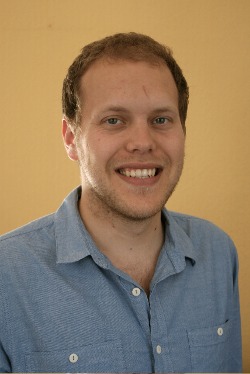Mitarbeiter - Resonator-QED
| Martin Eckstein | |||||||
|
Publications(up to 2010)
-
Three-Level Physics of a Single Atom Coupled to a High Finesse Cavity, (2010), DiplomarbeitBibTeX
-
Optical control of the refractive index of a single atom, Phys. Rev. Lett. 105, 153603 (2010)arXivBibTeX ABSTRACT »
ABSTRACT »We experimentally demonstrate the elementary case of electromagnetically induced transparency with a single atom inside an optical cavity probed by a weak field. We observe the modification of the dispersive and absorptive properties of the atom by changing the frequency of a control light field. Moreover, a strong cooling effect has been observed at two-photon resonance, increasing the storage time of our atoms twenty-fold to about 16 seconds. Our result points towards all-optical switching with single photons.
-
Analyzing quantum jumps of one and two atoms strongly coupled to an optical cavity, J. Opt. Soc. Am. B 27, A152 (2010)arXivBibTeX ABSTRACT »We induce quantum jumps between the hyperfine ground states of one and two Cesium atoms, strongly coupled to the mode of a high-finesse optical resonator, and analyze the resulting random telegraph signals. We identify experimental parameters to deduce the atomic spin state nondestructively from the stream of photons transmitted through the cavity, achieving a compromise between a good signal-to-noise ratio and minimal measurement-induced perturbations. In order to extract optimum information about the spin dynamics from the photon count signal, a Bayesian update formalism is employed, which yields time-dependent probabilities for the atoms to be in either hyperfine state. We discuss the effect of super-Poissonian photon number distributions caused by atomic motion.
ABSTRACT »We induce quantum jumps between the hyperfine ground states of one and two Cesium atoms, strongly coupled to the mode of a high-finesse optical resonator, and analyze the resulting random telegraph signals. We identify experimental parameters to deduce the atomic spin state nondestructively from the stream of photons transmitted through the cavity, achieving a compromise between a good signal-to-noise ratio and minimal measurement-induced perturbations. In order to extract optimum information about the spin dynamics from the photon count signal, a Bayesian update formalism is employed, which yields time-dependent probabilities for the atoms to be in either hyperfine state. We discuss the effect of super-Poissonian photon number distributions caused by atomic motion.
Forschungsgebiete
Unsere Gruppe
Veröffentlichungen
Abgeschlossene Projekte
Lehre
Weitere Informationen
Anmeldung
Vorträge
- Curtius Lectures
- 03/05/22 - 06/05/22










